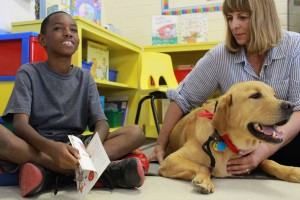 Children with anxiety disorders may have unique needs and difficulties in a school setting. For children with social anxiety or social phobia, interacting with peers or doing school presentations can be terrifying. Some kids may actually become physically ill when faced with an upcoming presentation. Others may be afraid to answer or ask questions in class because of a fear of what their peers will think of them. This can hurt these anxious kids’ education, as it keeps them from being able to fully engage in their classroom learning.
Children with anxiety disorders may have unique needs and difficulties in a school setting. For children with social anxiety or social phobia, interacting with peers or doing school presentations can be terrifying. Some kids may actually become physically ill when faced with an upcoming presentation. Others may be afraid to answer or ask questions in class because of a fear of what their peers will think of them. This can hurt these anxious kids’ education, as it keeps them from being able to fully engage in their classroom learning.
Younger children tend to be more prone to separation anxiety disorder. In many young children, separation anxiety is just a phase that will be outgrown. As a condition, however, separation anxiety causes a child to deeply dread and fear being away from a trusted loved one or guardian.
Both social anxiety and separation anxiety disorder can lead to school anxiety and even school refusal. Tantrums may erupt at home or at school when a parent or guardian insists on a child’s attending school. Some parents may not even realize their child has an anxiety disorder, making it difficult for them to understand the cause of their son or daughter’s behavior. When an undesirable behavior (e.g., tantrums before school every day) is persistent and disruptive to a household, parents and children can benefit from a consultation with a licensed mental health professional.
Traditionally, therapy is administered in a therapist’s office. Other settings for therapy include a community mental health center, a hospital, and the patient’s home.
Recently, some mental health workers have begun to consider administering therapy in a new setting: schools.
Mychailyszyn et al. (2011) wrote a paper which discusses therapy for anxious children in schools.
The researchers used one of the most effective forms of therapy, Cognitive Behavioral Therapy (CBT), to see how school-based therapy works for anxious kids. CBT teaches you to change your way of thinking and analyzing events. Usually, people who have anxiety or depression are very focused on negative ideas, many of which do not reflect reality.
The article describes how school workers can be taught to treat mild anxiety and avoidance in students. One of the suggestions the researchers came up with based on their findings included breaking up treatment sessions so that they would not interfere with other school activities.
The article also provides some interesting and helpful information on anxiety in kids, especially related to separation anxiety disorder, generalized anxiety disorder (GAD), and social phobia.
Photo Credit: Cici, over there! via Compfight cc





